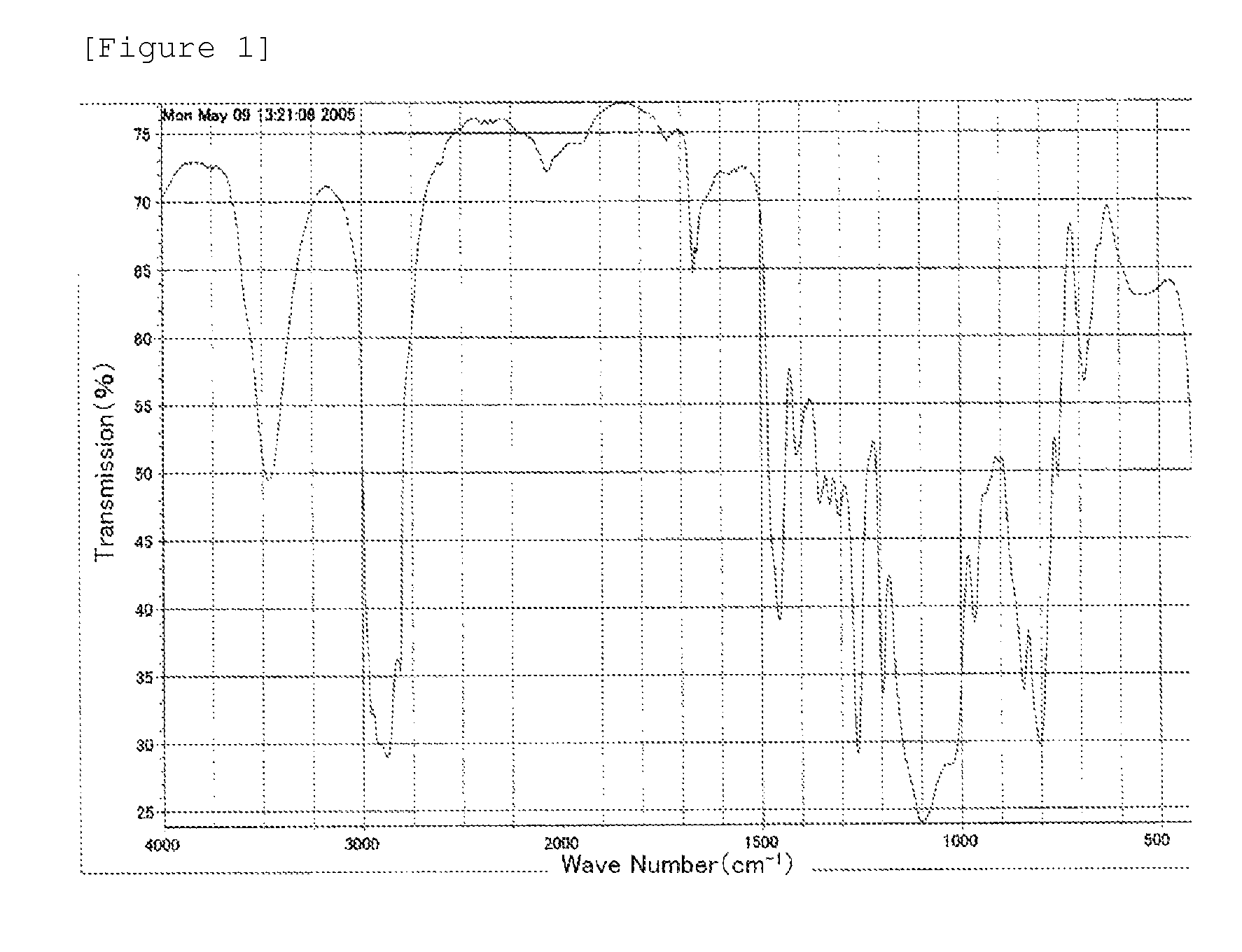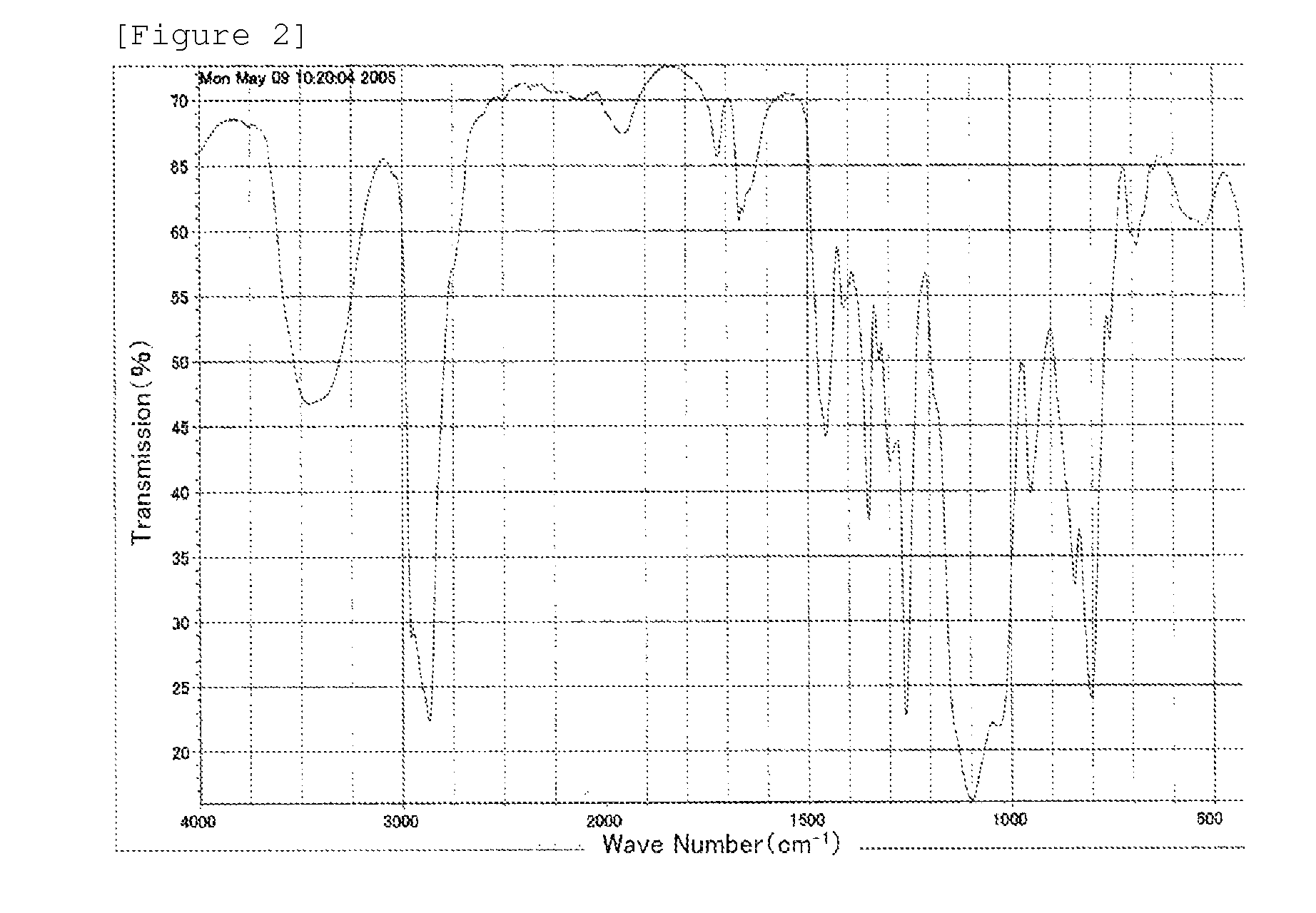Polyether-modified organopolysiloxane, diorganopolysiloxane-polyether block copolymer, their production methods, and cosmetic preparation
a technology of polyether block and organopolysiloxane, which is applied in the field of polyethermodified organopolysiloxane, diorganopolysiloxanepolyether block copolymer, their production methods, and cosmetic preparation, can solve the problems of reducing the production efficiency of polyoxyalkylene mono-1-propenyl ether, unable to prevent the production of carbonyl-functional allergenically antigenic compounds, and unable to increas
- Summary
- Abstract
- Description
- Claims
- Application Information
AI Technical Summary
Benefits of technology
Problems solved by technology
Method used
Image
Examples
reference example 1
[0433]13C-NMR analysis of a commercial glycidyl methyl ether that contained residual starting material from the synthesis process and organochlorine compound by-products showed that this commercial glycidyl methyl ether contained 3.4 mol % (13700 ppm chlorine) as epichlorohydrin equivalent. 500 g of this glycidyl methyl ether was placed in a four-neck flask equipped with a thermometer, reflux condenser, and stirrer; 25 g of sodium hydroxide powder (average particle diameter ≧300 μm) was introduced (this sodium hydroxide powder had been obtained by crushing sodium hydroxide lumps with a hammer); and stirring was carried out for 3 hours at 80° C. under a nitrogen blanket. Simple distillation was then carried out at a reduced pressure of 40-50 mmHg to obtain a 360 g of fraction. This fraction was analyzed by NMR and was thereby shown to be methyl glycidyl ether with a purity of 99.9%. Signals associated with the impurities did not appear on the NMR analytical chart. This methyl glycidy...
reference example 2
[0434]3.90 g (37.8 mmol) of ethylene glycol monoallyl ether, 0.05 g (0.90 mmol) of potassium hydroxide powder, and 20.0 g (227 mmol) of methyl glycidyl ether purified as in Reference Example 1 were introduced into a four-neck flask equipped with a thermometer, reflux condenser, and stirrer and were stirred for 2 hours at 120-130° C. under a nitrogen blanket. The reaction was cooled to room temperature and the polymerization was stopped by the addition of 0.060 g of acetic acid with stirring. 10 g toluene was added to the liquid polymerization product; 1 gram Kyoward 500SN, a hydrotalcite-type adsorbent from Kyowa Chemical Industry Co., Ltd., was then added; and stirring was carried out for 2 hours. The potassium acetate by-product and the adsorbent were removed by filtration and the low boilers were distilled off by heating the filtrate under reduced pressure to obtain 22.7 g (yield=95%) of a clear liquid residue. Analysis of this liquid residue by GPC gave a number-average molecula...
reference examples 3 to 5
[0437]Liquid poly(methyl glycidyl ether)s having different degrees of polymerization were prepared by carrying out polymerization and so forth under the same conditions as in Reference Example 2, with the following exceptions: the amount of ethylene glycol monoallyl ether charged was changed from that in Reference Example 2 and potassium t-butoxide was used as the polymerization catalyst rather than potassium hydroxide. The values for general formula (7) were as follows: R=allyloxyethyl, n as reported below, W=methyl, m=0, p=1, and Y=hydrogen atom. The amounts charged and the analytical results are reported in Table 1 below.
[0438]
TABLE 1ReferenceReferenceExample 3Example 4Reference Example 5ethylene glycol1.86 g0.93 g0.46 gmonoallyl ether18.2 mmol9.1 mmol4.5 mmolpolymerization catalystt-BuOKt-BuOKt-BuOK0.1 g0.1 g0.1 g0.9 mmol0.9 mmol0.9 mmolyield21.4 g20.8 g20.5 g% yield98%99.5%100%number-average163826784214molecular weightpolydispersity1.0631.0531.078average degree of12.32548polyme...
PUM
| Property | Measurement | Unit |
|---|---|---|
| mol % | aaaaa | aaaaa |
| mol % | aaaaa | aaaaa |
| pH | aaaaa | aaaaa |
Abstract
Description
Claims
Application Information
 Login to View More
Login to View More - R&D
- Intellectual Property
- Life Sciences
- Materials
- Tech Scout
- Unparalleled Data Quality
- Higher Quality Content
- 60% Fewer Hallucinations
Browse by: Latest US Patents, China's latest patents, Technical Efficacy Thesaurus, Application Domain, Technology Topic, Popular Technical Reports.
© 2025 PatSnap. All rights reserved.Legal|Privacy policy|Modern Slavery Act Transparency Statement|Sitemap|About US| Contact US: help@patsnap.com



